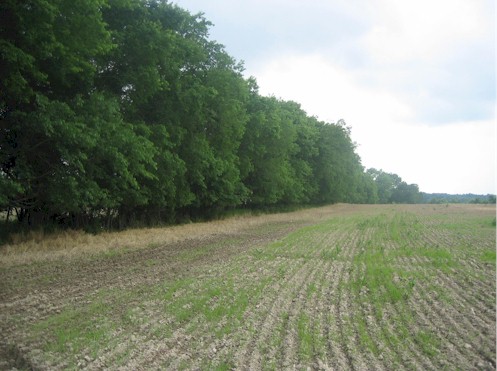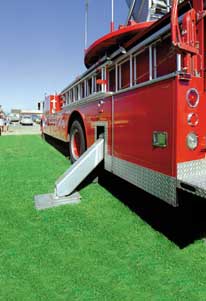|
Earlier
this year Doug Cole, a principal in the Design Forum
land planning firm, found himself stumped by a
dilemma described in Bacon's Rebellion some
time back: Design
by Fire Truck.
Cole's
firm was the lead designer for Wilton on the James,
a New Urbanism project planned in eastern Henrico
County. Like the planners for the Tree Hill project
I wrote about in "Design by Fire
Truck,"
Cole's ambition to create narrow,
pedestrian-oriented streets was trumped by the
safety concerns of the Henrico County fire
department. The main boulevard through Wilton on the
James, Cole was told, would be too narrow to
accommodate the outriggers used to stabilize the big
fire-fighting rigs.
That
posed a major problem: The boulevard was a critical
element around which the entire Wilton plan
revolved. Widening the lanes to make them fire-truck
friendly would invite motorists to drive
faster. Speeding cars would transform the street
from a people zone into a car zone. And that would
ruin everything that the developer HHHunt was trying
to accomplish.
In
my previous article, I left the Tree Hill planners
in a state of limbo, unsure of whether or not they would
work out their problems. But Cole persisted
in finding a solution -- adding a bike lane -- and,
in doing so, created an entire new dimension for the
development that had not been part of its original conception.
I
tender this tale to celebrate the spirit of
creativity. Designing livable communities at an
affordable price is incredibly difficult. There are
so many elements to consider, so many trade-offs to
make, so many regulations to abide by, so many
constituencies to please, that the job may seem
impossible. But Design Forum cut through this
particular problem
with a solution that seems simple and eloquent in
retrospect but was hardly obvious at the time. Bacon's
Rebellion plans to tell more stories like these in
the future, and we invite readers to let us know of
others.
Wilton
on the James marks the outer edge in a string of
major New Urbanism projects along the James River
that would bring upscale development for the first
time to eastern Henrico County. Rocketts Landing,
which overlaps Henrico and the City of Richmond,
would re-develop an old industrial district hugging
the river. Just beyond, Tree Hill would create a
mixed use project with a high-density town
center. Skipping a few properties out to the
Interstate-895 bypass, Wilton would create a
lower-density, mixed-use "village" of
3,200 dwelling units arrayed around a
retail-oriented town center. The project has
received zoning approval but still has a number of
issues to resolve before construction begins.
A
dominant feature of Wilton property is a hedgerow of
mature trees and underbrush. In the early stages of
the project, the designers
fixed on the idea of organizing the community around
the hedgerow: They envisioned the line of trees running
down the median of the main boulevard. Inspired by
Richmond's Monument Ave., Cole proposed making the
boulevard the project's "power street,"
lined with large, handsome houses.
|

|
Wilton
on the James will build its main boulevard
around this hedgerow, which bisects the Wilton
property. |
The
boulevard will function as one of the project's main
interior arteries, linking the town center with the
community center. In the original plans, Cole
conceived of four lanes divided by the median: two
lanes running one way, two the other.
Eight-foot-wide outer lanes would be set aside for
parking, while 14-foot-wide inner lanes would be
reserved for moving cars. In between, he planned for
65 feet of green space, with the hedgerow running
down the center.
This
rendering shows the layout of the main section of
Wilton on the James. The main boulevard can be seen
in the middle as a green strip running northeast to
southwest.
A
core goal of New Urbanism is to create pedestrian-
friendly streetscapes. There are many tricks to the
trade, but one of the most basic is to keep the
streets narrow. There is a direct correlation
between the width of traffic lanes and the speed at
which people drive, regardless of what the posted
speed limits might be. Narrowing the lanes forces
people to slow down and drive more carefully, and
that makes pedestrians feel safer.
Henrico
County planners liked the plan, recalls Cole, but
the fire chief took one look and called a halt to
it. Fire fighters needed 20 feet of unobstructed
pavement for their outriggers.
New
Urbanists argue that more people are likely to
die in automobile accidents caused by poor
street design than will die in house fires
that fire trucks can't reach. County
planners around the country often accept that logic, but fire
marshals are more cautious. In Henrico County,
as in many other counties, the fire chief calls the
shots.
"Design by
fire truck" is a national phenomenon.
For
Cole, keeping the travel lanes narrow was critical. Why couldn't
the fire truck pull to the edge of the lane and
extend its outrigger into the grass of the median,
he asked.
That
wouldn't work, he was told, someone might plant a tree and block
the way.
|

Outriggers used to stabilize
fire trucks can extend the effective width of
the vehicle by
several feet on each side. (Photo credit: Invisible
Structures Inc.)
|
What
if he planted a porous pavement system in the median
that provided structural support for the outriggers?
Grass could grow through but not trees.
No,
there still was a possibility that a tree
could grow and prevent the outrigger from occupying
the ideal location.
What
if he added sidewalks to the median strip, one on either side of
the hedgerow? No one would plant a tree in the
middle of a sidewalk!
No
again. If it snowed, a plow might shove the street
snow into the median, covering the sidewalk
|
and
making it inaccessible to an outrigger.
What
if Cole widened the alleys in the back of the
houses? He could make them 20 feet wide.
No,
fire fighters respond to specific street addresses,
so they have to go to the front of a house.
What
if he clearly marked street addresses in the back of
the houses?
No.
"We
were at wits end," confesses Cole. The fire
chief wanted six more feet, but widening the travel
lane would materially damage the vision for the
Wilton project.
In
desperation, Cole and his fellow designers held a
mini-charrette in their Fan office. There, amidst
the brain storming, the germ of an idea sprouted.
What if they added a six-foot bicycle lane between
the parked cars and the travel lane? The bicycle
lane would provide the hard pavement space that the
fire department wanted, and it would add a
significant amenity to the project.
The
idea had promise, but it needed noodling. What good
was a bike lane that went from Point A to Point B?
To encourage people to use their bicycles, the
village would have to create a network of lanes
that connected a variety of destinations. As the
ideas kept flowing, the designers figured they could
add an offshoot to the elementary school, run a bike
lane along the creek, and extend a link to the
planned Capital Trail bike path that one day will
run all the way from Richmond to Williamsburg.
The
developers liked the idea. So did the people in
charge of the Capital Trail. In fact, they decided
to loop the trail through Wilton,
following two miles of riverfront. When built, the
Wilton bike trail network will be an integral and
picturesque part of the Capital Trail.
Yellow-orange
trails are the trails originally proposed by HHHunt.
Red marks the James River trail, blue the Wilton
Park Way trail, and bright yellow a James River
alternate route added as a result of integration
with the Capital Trail.
Now,
says Cole, the Henrico fire department is happy, and
so are the developers. Not only will the pedestrian
orientation of the community be preserved, Wilton on
the James will have an additional distinction as one
of the more bicycle friendly venues in Virginia.
--
June 19, 2007
|
